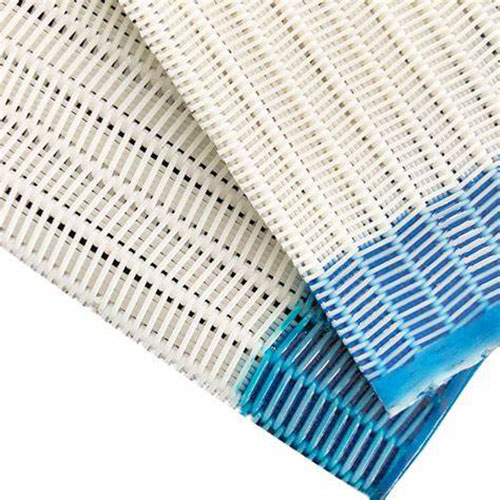The Specific Application of Polyester Spiral Filter Screen?
2025-05-27
Main uses of polyester spiral filter Screen (detailed version)
Polyester spiral filter screen (or polyester spiral dryer) has become a high-performance, multifunctional industrial drying and filtering medium with its unique polyester monofilament spiral weaving structure and fillable mesh design (forming a polyester spiral filter). It plays a key role in many production links that have stringent requirements on air permeability, strength, temperature resistance and chemical corrosion resistance. Its main uses are concentrated in the following core areas:

1.Papermaking industry
Core role: It can replace the dry blanket in the drying section of the papermaking machine, play a drying role and reduce costs. It is suitable for a variety of paper production scenarios with large drying quantities, including but not limited to packaging paper, cultural paper, board paper and pulp board.
Specific advantages:
High air permeability, good drying effect, short drying time, saving production time.
Good strength, long service life, and smooth operation: The spiral structure combined with the excellent performance of polyester monofilament provides extremely high dimensional stability, can withstand high tension and long-term repeated high-temperature cycles (usually above 150°C), ensure the long-term stable operation of the paper machine, and reduce end breaks.
High temperature & hydrolysis resistance: The special polyester material performs well in the high temperature (100°C - 140°C all year round) and high humidity environment of the paper machine drying section, far better than most synthetic fibers, and has a long service life.
Reduce rewetting: The optimized breathable structure helps to discharge the water vapor generated by drying in time, reduce rewetting, and improve drying efficiency.
The flat surface of the net can improve the quality of the paper surface: The smoothness and uniformity of the dry net surface help to obtain good paper surface flatness. Specially designed spiral net joints (such as spiral plug-in) can also significantly reduce paper surface marks.
2. Printing and dyeing and textile industry
Core role: In the drying section of the setting machine, dryer, hot air stenter and other equipment, it serves as the support, conveyor and guide belt for the fabric to run.
Specific advantages:
High heat resistance: It can withstand the high temperatures commonly seen in the dyeing and finishing process (hot air and drying drum temperatures are often 180°C - 230°C, or even higher), and maintain the structural strength without deformation or softening.
Chemical corrosion resistance: It resists the erosion of dyes, auxiliaries, acids and alkalis and other chemicals to avoid early failure or contamination of fabrics due to corrosion.
High dimensional stability & low elongation: It ensures the accuracy of the tension and shape control of the fabric at high temperatures, and prevents the fabric from being skewed and deformed.
Good air permeability/permeability: It allows hot air to penetrate the fabric evenly (or controls the airflow in specific designs), improving drying efficiency and uniformity. Some processes require extremely high air permeability, which can be met by unfilled spiral dry nets; while parts that require less air permeability (such as transfer printing machines) may use versions with low air permeability.
Smooth and wear-resistant surface: Reduce scratches and wear on the fabric surface and protect the surface quality of the fabric.
3. Industrial filtration and dehydration field (polyester spiral filter)
Core function: In the process of solid-liquid separation, as a filter screen/filter cloth, intercept solid particles, allow liquid to pass through or be used to evenly distribute vacuum/airflow for dehydration.
Main application scenarios:
Sludge dehydration (belt filter press/vacuum belt conveyor): As a filter belt, relying on an extremely fine mesh structure, it can effectively intercept fine sludge particles, reduce material loss ("running"), and increase the solid content and processing efficiency of the mud cake. Its high strength and high wear resistance are suitable for continuous high-pressure extrusion or vacuum filtration environments.
Pulp washing and thickening: Used as a filter on equipment such as pulp washers and thickeners to intercept pulp fibers and allow black liquor or white water to be discharged. High-density mesh reduces the loss of fine fibers and fillers, reducing production costs.
Coal washing (coal dehydration): Intercept impurities such as coal slime in sedimentation centrifuges, screens, and filters to achieve dehydration and recovery of coal slime or solid-liquid separation of coal slurry.
Food and biomass dehydration: Wine lees/vinegar lees dehydration: Separate the solid residue (wine lees/vinegar lees) after alcohol or vinegar production. The characteristics of chemical corrosion resistance and microbial corrosion resistance are crucial, and the filler structure can effectively prevent the loss of fine fermentation residues.
Dehydration of agricultural product processing waste residues such as potato residues and bean residues. Chemicals (powder/crystallization): The separation of catalyst particles, crystals or other chemical product mother liquors during the filtration process requires high strength, corrosion resistance and fine filtration to prevent product loss.
Other solid-liquid separation scenarios: Such as dehydration and washing of metallurgical slag, pigments, ceramic raw materials, etc.



